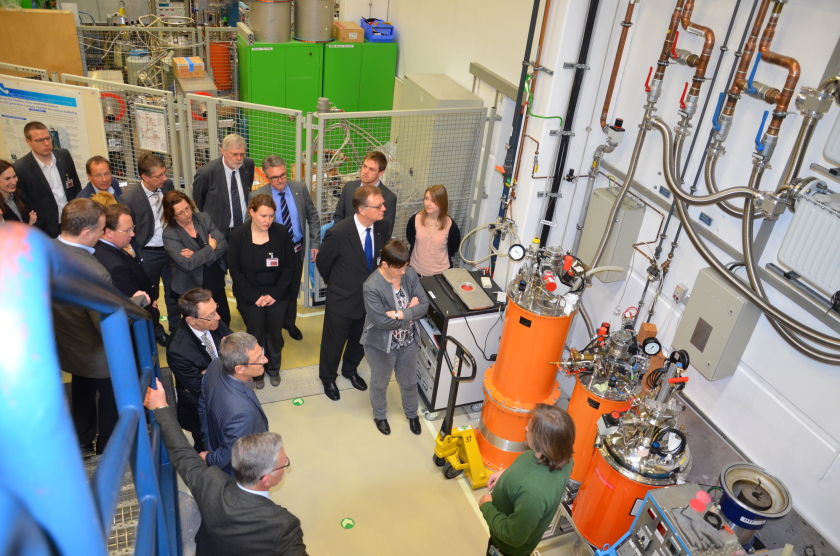Deutsche Gesellschaft für Materialkunde was a guest of HZB

Tour through the experimental hall of BER II.
From 15 to 16 March, the Deutsche Gesellschaft für Materialkunde, DGM (German association of materials science), held its closed board meeting and Advisory Council meeting at HZB. The experts took the occasion to visit the synchrotron source BESSY II and the neutron source BER II, gaining an insight into important future projects of HZB.
“It was a great pleasure to be host to the Deutsche Gesellschaft für Materialkunde, where we had the opportunity to present Helmholtz-Zentrum Berlin’s strategies and research infrastructures, which external researchers are also very welcome to use,“ says Prof. Dr. Anke Kaysser-Pyzalla, scientific director of HZB.
The board members of the DGM visited the control room and experimental hall of BESSY II on 15 March. On 16 March, the DGM Advisory Council toured the neutron guide hall at BER II and the CoreLab “Correlative Microscopy and Spectroscopy”, which is home to latest generation ZEISS electron and ion microscopes for use by external users and employees of HZB.
The Deutsche Gesellschaft für Materialkunde is dedicated to promoting continual advancements in topics, structures and careers in the field of materials science and engineering. Its strategies include fostering cooperation between universities, research institutions, companies, and national and international partners, and promoting new collaborative projects. The DGM organises many symposia and congresses that are also important information exchange platforms for many scientists of HZB.
(sz)
https://www.helmholtz-berlin.de/pubbin/news_seite?nid=14638;sprache=en
- Copy link
-
Battery research with the HZB X-ray microscope
New cathode materials are being developed to further increase the capacity of lithium batteries. Multilayer lithium-rich transition metal oxides (LRTMOs) offer particularly high energy density. However, their capacity decreases with each charging cycle due to structural and chemical changes. Using X-ray methods at BESSY II, teams from several Chinese research institutions have now investigated these changes for the first time with highest precision: at the unique X-ray microscope, they were able to observe morphological and structural developments on the nanometre scale and also clarify chemical changes.
-
Hydrogen: Breakthrough in alkaline membrane electrolysers
A team from the Technical University of Berlin, HZB, IMTEK (University of Freiburg) and Siemens Energy has developed a highly efficient alkaline membrane electrolyser that approaches the performance of established PEM electrolysers. What makes this achievement remarkable is the use of inexpensive nickel compounds for the anode catalyst, replacing costly and rare iridium. At BESSY II, the team was able to elucidate the catalytic processes in detail using operando measurements, and a theory team (USA, Singapore) provided a consistent molecular description. In Freiburg, prototype cells were built using a new coating process and tested in operation. The results have been published in the prestigious journal Nature Catalysis.
-
Perovskite solar cells: TEAM PV develops reproducibility and comparability
Ten teams at Helmholtz-Zentrum Berlin are building a long-term international alliance to converge practices and develop reproducibility and comparability in perovskite materials. The TEAM PV project is funded by the Federal Ministry of Education and Research (BMBF), Germany.
